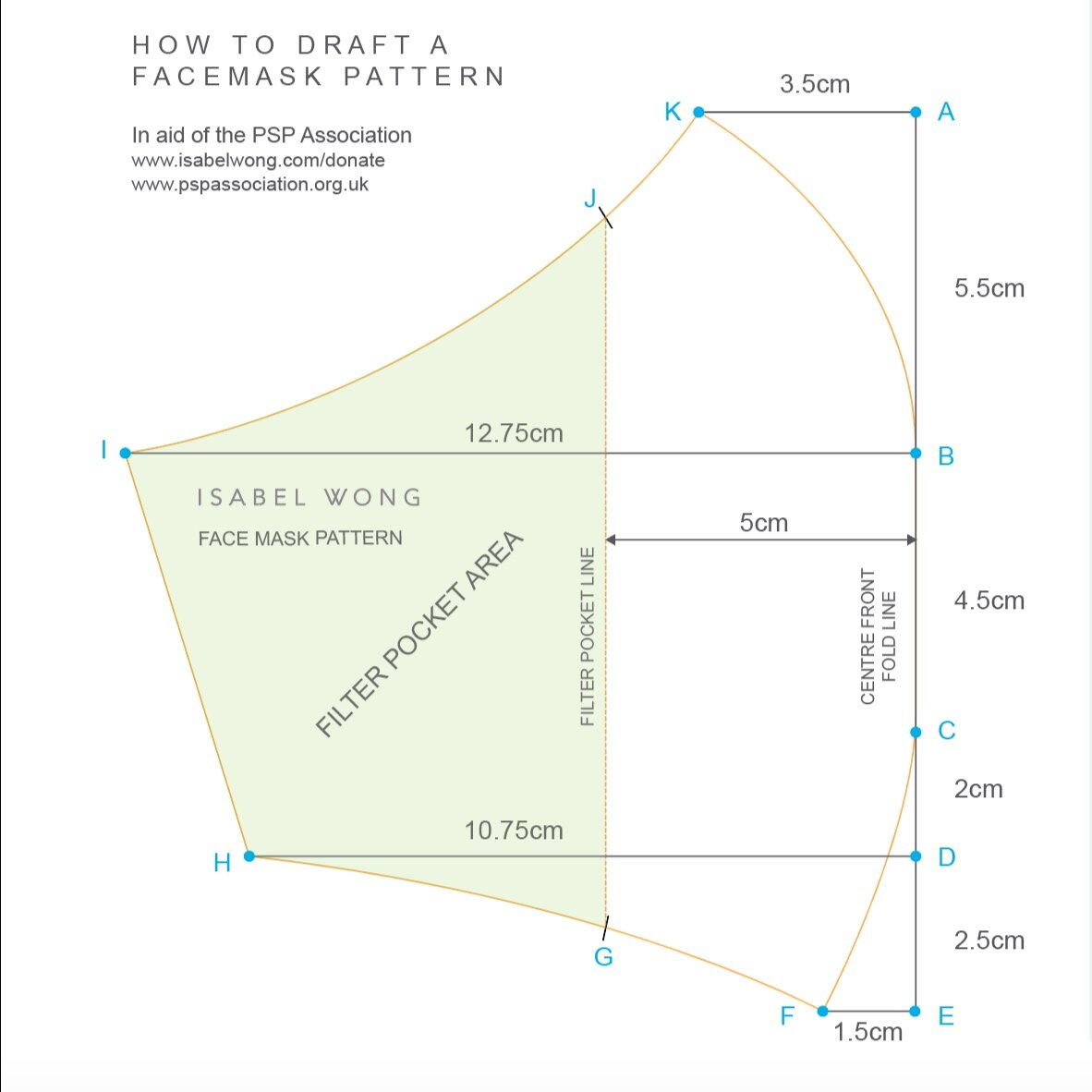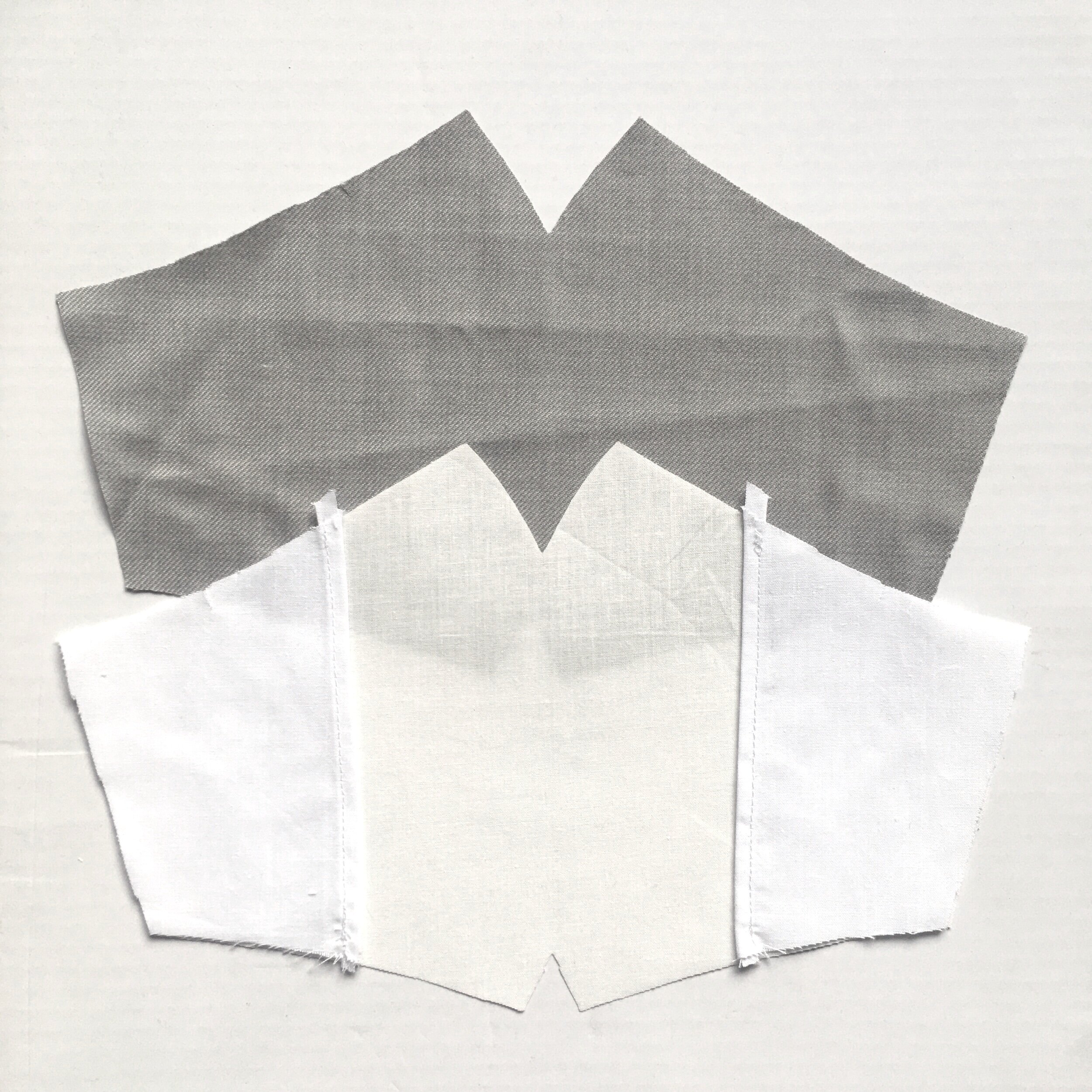HOW TO MAKE A FACE MASK
Step by Step Guide
We have created this guide during the Covid-19 pandemic and in aid of the PSP Association, a charity supporting people with rare neurological conditions (CBD and PSP).
WHAT YOU’LL NEED
Face mask pattern
DRAFT A PATTERN →
DOWNLOAD PATTERN → free of charge however a small donation to our cause would be greatly appreciated!ORDER PATTERN → make a donation to receive a pattern by post
Please note our patterns are copyright to Isabel Wong and are not for commercial useMain Fabric 30cm x 17cm
Choose a tightly woven high thread count fabric that is breathable such as shirting or bedding cotton. You can use the same fabric for the lining and outer layer.
Lining Fabric 50cm x 17cm
Elastic
Universal Size 4 x 15cm
Women’s Size 2 x 12cm
Men’s Size 2 x 16cm(if you don’t have elastic, use some hair ties instead or you can make some straps using a stretch fabric)
Optional filter
Melt blown (non woven) filter fabric 27 x 14cm or tissue if you do not have access to filter fabricOptional nose wire 9cm
Scissors
Iron
Sewing machine (or needle if you do not have a sewing machine)
Needle
Thread
INSTRUCTIONS
See images above for reference
STEP 1
DRAFT A PATTERN →
DOWNLOAD PATTERN → free of charge however a small donation to our cause would be greatly appreciated!
ORDER PATTERN → make a donation to receive a pattern by post
Please note our patterns are copyright to Isabel Wong and are not for commercial use
STEP 2
Cut out pattern
STEP 3
Fold fabric and align centre front along the folded edge
Step 4
Cut out pieces - do not cut along the centre front fold
1 x Main Piece in outer fabric
1 x Main Piece in lining fabric
2 x Filter Pocket in lining fabric
STEP 5
Finish the raw edge on the longest vertical side of the filter pockets using a rolled hem or any other method to prevent it from fraying.
For a rolled hem, you can use a roller foot or fold over 5mm and fold again another 5mm to hide the raw edge then stitch down
STEP 6
Fold the main pieces at the centre front line and sew along the curves (nose and chin areas), tapering into the fold line and missing out the centre section
STEP 7
Open out the main pieces you have just sewn and press down the seams using an iron
Place the filter pockets on top of the main lining piece
STEP 8
(option 1)
If you are making a universal size, cut 4 x 15cm length elastic and position on the four corners as pictured.
(option 2)
If you are making a fixed size, cut 2 lengths of elastic and position on the four corners as pictured.
For women, we recommend 2 x 12cm elastic
For men, we recommend 2 x 16cm elastic
STEP 9
Place the main outer piece on top, sandwiching the filter pockets and elastic in between. The main pieces should be right side facing right side so that only the wrong sides should be visible. Pin along the edges
STEP 10
Sew along the top and bottom edges
Sew down the sides, make sure the elastic is positioned well and securely stitched down.
Leave a small gap unstitched on one of the edges
STEP 11
Bag out by pulling through the small gap and turning the entire piece inside out
STEP 12
Use a pair of scissors or a knitting needle (anything with a blunt point should do the trick) and push out the corners from the inside for a crisp corner
Step 13
Press all the edge with an iron & tie a knot in the elastic on each end if you are making the universal size mask
Optional: to insert a nose wire, place the wire inside and centred along the top edge. Secure in place with a few stitches.
STEP 14
Close the opening with a slip stitch
STEP 15 (optional)
Insert a filter layer into the pockets using either a melt blown (non woven) filter fabric or tissue. This is optional but will offer you an added layer of protection
FINISHED!
Your face mask is ready to use!
DISCLAIMER
The following disclaimer applies to the face masks/coverings made by us and any homemade masks made by you where our pattern and step-by-step guide has been used.
Our face masks/coverings are not intended for use as a replacement for Personal Protective Equipment (PPE) and are not a licensed product or approved for use in clinical/hospital settings. If in doubt or in circumstances where PPE use is required, you should consult a healthcare professional or your healthcare management/trust for guidance. Our masks have not undergone any regulatory product testing and are not proven against the spread of viruses nor claims to have any protective guarantees or health benefits. These masks are designed to be used by the general public as a precautionary measure and in conjunction with social distancing and personal hygiene practices such as regular hand washing and refraining from face-touching, as recommended under UK government guidelines. Use masks with caution and avoid use under strenuous physical activity, for prolonged periods of time or where breathing is restricted. Should you experience any breathing difficulties whilst using our face coverings, please remove immediately. If you have pre-existing health or respiratory conditions, please consult a healthcare professional for advice before using. Our masks are for adult use only - Infants and young children should not use our masks and should be supervised at all times. Face masks should be washed between 40-60°C before first use and after every use. The decision to use these masks is solely your own and at your own risk. We cannot accept any liability in the case of accidents, injuries or health complications as a result of using them. Please also note that our fundraiser is not sponsored, endorsed nor affiliated with the PSPA in any way other than being the chosen recipient of the charitable donations raised by our initiative. The PSPA are not involved in the making, supply or distribution of our masks and cannot be held accountable in the case of accidents, injuries or health complications as a result of using these masks.
For more information and advice, please refer to Public Health England→


















